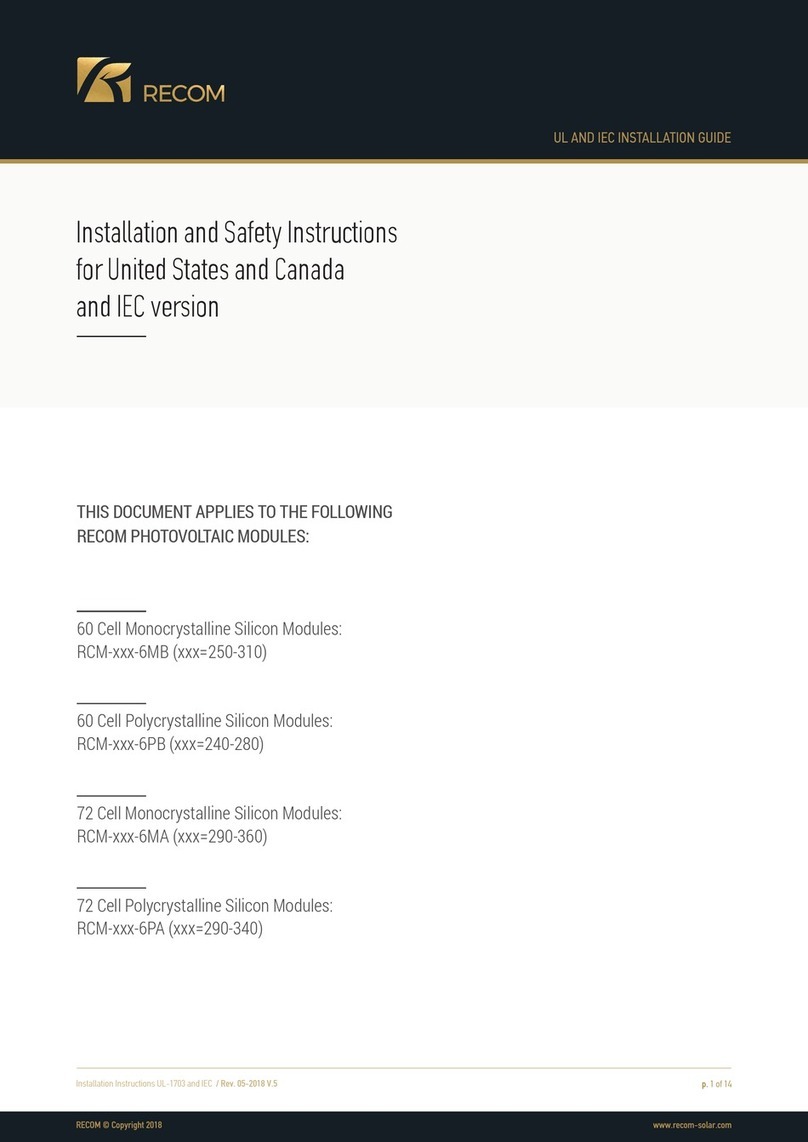
p. 10 of 14
Installation Instructions IEC / Rev. 05-2018 V.5
IEC INSTALLATION GUIDE
RECOM © Copyright 2018 www.recom-solar.com
4. ELECTRICAL INSTALLATION
General Installation Guidelines
• Any hardware used must be compatible with the mounting structure material to avoid galvanic corrosion.
• It is not recommended to use modules with different congurations (grounding, wiring) in the same system.
• For applications requiring a high operating voltage several modules can be connected in series to form a
string of modules. The system voltage is then equal to the sum of the voltage of each module.
• For applications requiring high operating currents several strings of modules can be connected in parallel;
the system current is then equal to the sum of the current of each string of modules.
• The maximum number of series connected modules depends on system design, the type of inverter used
and environmental conditions. The number of modules connected to an inverter should be within the in-
verter voltage limits and operating range. Do not exceed the maximum system voltage permitted by the
manufacturer. Do not exceed the maximum system voltage of 1,000V.
• There is no limitation on the number of modules that can be connected in parallel; the number of modules
is determined by system design parameters such as current or power output.
• In the case of parallel connection a protection against excessive reverse currents must be installed. The
maximum allowed reverse current is 15A and the maximum series fuse rating is 15A.
• Under normal conditions, a photovoltaic module is likely to experience conditions that produce more current
and/or voltage than reported at standard test conditions. Accordingly, the values of Isc and Voc marked on
this module should be multiplied by a factor of 1.25 when determining component voltage ratings, conduc-
tor ampacities, fuse sizes, and size of controls connected to the PV output.
• All relevant electrical installation codes and regulations should be observed for regulations on working at
heights and fall protection.
• To prevent the cables and the connectors from overheating, the cross section of the cables and the capacity
of the connectors must be selected to suit the maximum system short circuit current. For eld connections,
use minimum 4mm² copper wires insulated for an operating temperature of 85°C. Use connectors with an
operating temperature of 105°C.
• The module junction box is rated IP67. Our modules are supplied with connectors to be used for system
electrical connections.
• All connectors and cables must be securely fastened. They must also have UV resistance and approval for
outside use. Secure cables using UV-resistant cable ties or other UV-resistant devices. Loose cables must
be protected from abrasion, sharp objects, animals etc. Avoid exposing cables as far as possible to direct
sunlight and permanent tension.




























